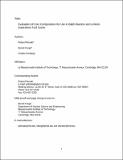Evaluation of core compositions for use in breed and burn reactors and limited-separations fuel cycles
Author(s)
Petroski, Robert; Forget, Benoit; Forsberg, Charles
DownloadAccepted version (1.483Mb)
Terms of use
Metadata
Show full item recordAbstract
Previously developed methods for analyzing breed-and-burn (B&B) reactors are applied to a wide range of core compositions. The compositions studied include different fuel types, steel and silicon carbide structure, and sodium, lead/lead bismuth eutectic (LBE), and gas coolants. These compositions are evaluated for use in "minimum burnup" B&B reactors in which it is assumed that blocks comprising the core can be shuffled in all three dimensions to flatten out non-uniformities in burnup. The two figures of merit evaluated are the minimum irradiation damage requirement and reactor fleet doubling time. To minimize irradiation damage, gas coolants perform best, followed by lead/LBE then sodium. High uranium-content metal fuel outperforms compound fuels, and different types of steel are similar and perform slightly better than silicon carbide. Once-through irradiation damage requirements can be surprisingly modest in minimum burnup B&B reactors, with a wide range of compositions viable at irradiation damage levels 50% higher than existing materials data. Doubling times were calculated for a reactor fleet consisting of B&B reactors operating in a limited-separations fuel cycle; i.e., a fuel cycle with no chemical separation of actinides. The effects of different cooling times and removal of fission products using a melt refining process are evaluated. To minimize doubling time, sodium cooled compositions perform best because they are able to achieve core power densities several times larger than compositions using other coolants. A hypothetical sodium-cooled core composition with high uranium content metal fuel, a low volume fraction of steel structure, and a high peak power density was calculated to achieve reactor doubling times on the order of one decade in such a fuel cycle. © 2012 Elsevier Ltd. All rights reserved.
Date issued
2013Department
Massachusetts Institute of Technology. Department of Nuclear Science and EngineeringJournal
Annals of Nuclear Energy
Publisher
Elsevier BV
Citation
Petroski, Robert, Benoit Forget, and Charles Forsberg. "Evaluation of Core Compositions for Use in Breed and Burn Reactors and Limited-Separations Fuel Cycles." Annals of Nuclear Energy 55 (2013): 151-68.
Version: Author's final manuscript